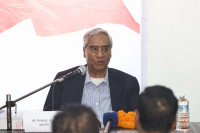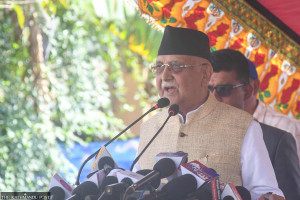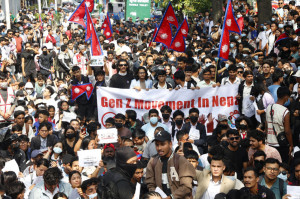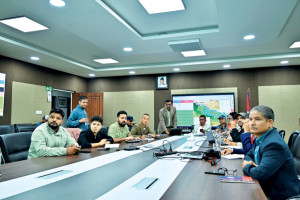Opinion
Undeclared borders
The Tarai-Madhes region lies along Nepal’s geographical border with India. This geographical proximity to India has resulted in cultural and linguistic commonalities that the people of the Madhes share with people across the border.
Kalpana Jha
The Tarai-Madhes region lies along Nepal’s geographical border with India. This geographical proximity to India has resulted in cultural and linguistic commonalities that the people of the Madhes share with people across the border. The Tarai’s proximity to India has led to the blurring of borders, with the Kathmandu-based polity constantly drawing and redrawing internal borders to maintain an emphatic distinction between the plains and the hills. One prominent example of this is the East-West highway. This highway, which was constructed with the aim of facilitating migration of the hill based populace into the Tarai, has become an important territorial dimension of identity construction. As a tacit border, the East-West highway also serves as a cultural boundary that offers protection against the infiltration of values deemed incompatible with the hegemonic values of the majority, thus creating a territorial organisation of power.
Road to division
Once built, the highway served as a new frontier between the hills and the plains. New economies prospered along the highway while once vibrant towns in the Tarai plunged into economic recession. This not only created a territorial line, it also compartmentalised the entire Tarai. The current state of Rajbiraj provides an outstanding example of what has happened because of the isolation of the Tarai.
Rajbiraj has the distinction of being the oldest planned town in Nepal. It was a pioneer in law education in Nepal and at one point it was also the district with the highest literacy rate. It has one of the oldest airports and one of the earliest planned industrial areas. However, today, this city is in ruins. Barely any flights take off from the airport, hardly any industries have been established recently and the educational standards are extremely low. On the political front, Rajbiraj was once a champion of democracy and federalism; Rajbiraj was where the call for republicanism was first heard. Today, however, the idea for secession has been conceived in the area.
On the one hand, the Nepali government constantly questions whether Madhesis are truly Nepalis because of their cultural resemblance to neighbouring Indians. On the other, state power has been culturally confined to Pahadiya characteristics where the governmental system is an expression of culturally formed will. Therefore, the territoriality of the government’s exclusionary practices—where numerous clearly defined borders have determined the parameters within which policies of control are shaped—have further compartmentalised the Tarai in general and towns like Rajbiraj in particular.
Split decision
Socially constructed notions of difference, fear and threat have impeded upward movement. Barriers make it difficult for people from the Tarai to compete in the job market and economic activities are adversely affected. One important example is the placement of the regional directorate for Saptari’s civil services in Dhankuta and the zonal offices for civil services in Diktel. Both Dhankuta and Diktel are hill districts. While Rajbiraj was made the zonal headquarter for the Sagarmatha zone, the location of the zonal office for civil services in Diktel and the strategic placement of administrative offices around the highway are reflective of the government’s determination of differences between the Madhesis and the hill populace. For instance, people from Rajbiraj have to travel a distance of 39km and go to Lahan for simple things like vehicle and license renewal. The rules and regulations imposed by the centre determine the existence of differences in the first place. Determining what, and who, is excluded or included through the creation of a boundary is an integral part of this process. Such boundaries always demarcate the parameters within which identities are conceived, perceived, perpetuated and reshaped. A small number of elites are involved in the decision making and law enforcement processes; these processes reinforce the idea of establishing borders.
Rajbiraj also represents how inappropriate government practices and policies have caused a fundamental crisis in the Madhes, resulting in a lack of education and health services and limited availability of facilities to increase productivity of land. Once known for the highest cultivation of rice grains and paddy, Rajbiraj’s cultivation now has fallen considerably. Poor access to markets resulting from poor connectivity and an unfair share in the economy has further exacerbated the differences.
Compartmentalisation is an important factor that contributes to determining which groups people belong to and identify with. The important factor to be noted here is that the strongest ethnic movements have emerged from these isolated areas. The correlation that can be drawn here is the stronger the compartmentalisation, the stronger the identity construction. By creating a cut-off point defined by physical boundaries, the centre has devised mechanisms that perpetuate difference.
Therefore, the state’s conscious process of shutting out opportunities has given rise to voices that demand rightful recognition and integration. Over the past decade, the state has managed to paint the Madhes as a land of anarchists and despots who are perpetuating divisive politics; justifying the increasing militarisation of these areas. Thus, the state has devised conflict as the new tool for boundary creation. It is important to realise that today’s conflict in the Tarai is a result of its long isolation; shutting the Madhes out of the negotiation process will further exacerbate inter-ethnic conflict in the near future.
Jha is a research associate at Martin Chautari




 18.12°C Kathmandu
18.12°C Kathmandu










